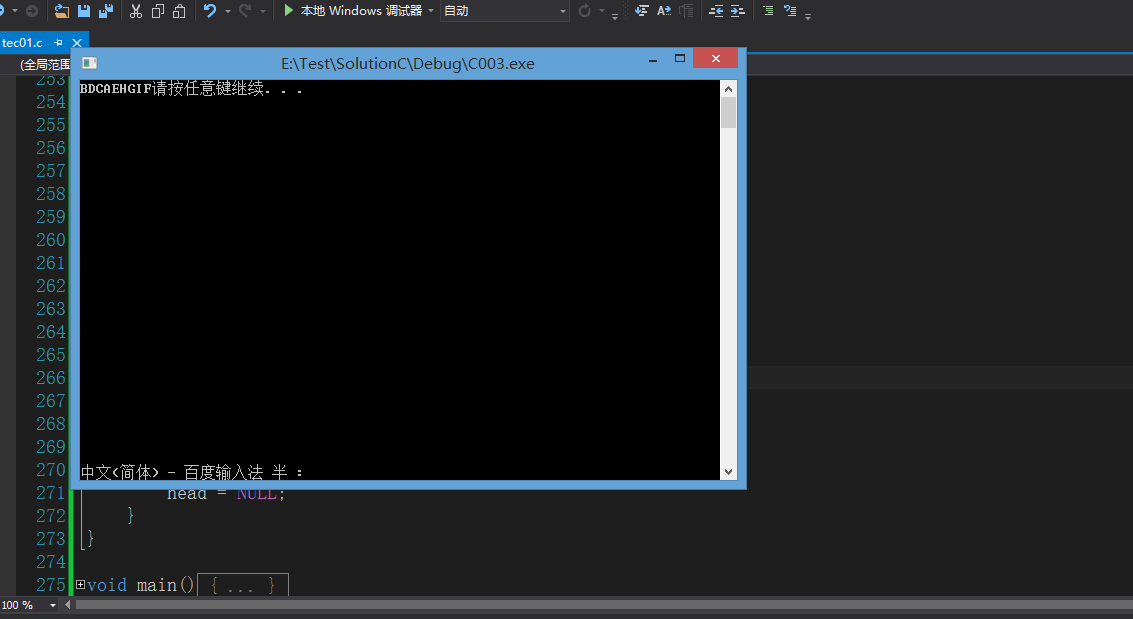
//二叉树的线索化
#include<stdio.h>
#include<stdlib.h>
#include<string.h>
//定义二叉树线索化节点
typedef struct _TreeNode{
char data;
char lefttag;//0表示没有线索化,1表示线索化---每次创建节点都会初始化 所以所有节点默认都是0
char righttag;
struct _TreeNode * leftchild;
struct _TreeNode * rightchild;
}TreeNode, *TreeNodePointer;
//定义前驱节点
TreeNodePointer pre = NULL;
/*
线索二叉树的定义
普通二叉树只能找到结点的左右孩子信息,而该结点的直接前驱和直接后继只能在遍历过程中获得。
n个结点的二叉链表中含有n+1(2n-(n-1)=n+1)个空指针域。
利用二叉链表中的空指针域,存放指向结点在某种遍历次序下的前趋和后继结点的指针(这种附加的指针称为"线索")。
备注:二叉树的遍历很复杂,销毁判断也会增加,暂时没看出任何优势所在,虽然花了我2天时间
线索化二叉树并不能通过头节点前驱,后继像链表一样顺序访问,因为原来的双亲节点的后继不是正确的
如图,如果正常的链表 A结点的后继应该是H 结果这里是E 根本无法顺序访问 如果以后有所顿悟 再来修改
*/
//创建树
TreeNodePointer CreateTree(){
//定义结构体对象
TreeNodePointer t1 = NULL, t2 = NULL, t3 = NULL, t4 = NULL, t5 = NULL, t6 = NULL, t7 = NULL, t8 = NULL, t9 = NULL;
t1 = (TreeNodePointer)malloc(sizeof(TreeNode));
if (t1 == NULL)
{
printf("分配内存失败!");
return NULL;
}
//初始化数据
memset(t1, 0, sizeof(TreeNode));
t2 = (TreeNodePointer)malloc(sizeof(TreeNode));
if (t2 == NULL)
{
printf("分配内存失败!");
return NULL;
}
//初始化数据
memset(t2, 0, sizeof(TreeNode));
t3 = (TreeNodePointer)malloc(sizeof(TreeNode));
if (t3 == NULL)
{
printf("分配内存失败!");
return NULL;
}
//初始化数据
memset(t3, 0, sizeof(TreeNode));
t4 = (TreeNodePointer)malloc(sizeof(TreeNode));
if (t4 == NULL)
{
printf("分配内存失败!");
return NULL;
}
//初始化数据
memset(t4, 0, sizeof(TreeNode));
t5 = (TreeNodePointer)malloc(sizeof(TreeNode));
if (t5 == NULL)
{
printf("分配内存失败!");
return NULL;
}
//初始化数据
memset(t5, 0, sizeof(TreeNode));
t6 = (TreeNodePointer)malloc(sizeof(TreeNode));
if (t6 == NULL)
{
printf("分配内存失败!");
return NULL;
}
//初始化数据
memset(t6, 0, sizeof(TreeNode));
t7 = (TreeNodePointer)malloc(sizeof(TreeNode));
if (t7 == NULL)
{
printf("分配内存失败!");
return NULL;
}
//初始化数据
memset(t7, 0, sizeof(TreeNode));
t8 = (TreeNodePointer)malloc(sizeof(TreeNode));
if (t8 == NULL)
{
printf("分配内存失败!");
return NULL;
}
//初始化数据
memset(t8, 0, sizeof(TreeNode));
t9 = (TreeNodePointer)malloc(sizeof(TreeNode));
if (t9 == NULL)
{
printf("分配内存失败!");
return NULL;
}
//初始化数据
memset(t9, 0, sizeof(TreeNode));
//填充数据域
t1->data = 'A';
t2->data = 'B';
t3->data = 'C';
t4->data = 'D';
t5->data = 'E';
t6->data = 'F';
t7->data = 'G';
t8->data = 'H';
t9->data = 'I';
//建立树之间的关系
t1->leftchild = t2;
t1->rightchild = t5;
t2->leftchild = NULL;
t2->rightchild = t3;
t3->leftchild = t4;
t3->rightchild = NULL;
// t5是t4的左孩子
t4->leftchild = NULL;
t4->rightchild = NULL;
//t5没有孩子节点
t5->leftchild = NULL;
t5->rightchild = t6;
t6->leftchild = t7;
t6->rightchild = NULL;
t7->leftchild = t8;
t7->rightchild = t9;
t8->leftchild = NULL;
t8->rightchild = NULL;
t9->leftchild = NULL;
t9->rightchild = NULL;
return t1;
}
//销毁树
void Destroy(TreeNodePointer * root){
if (root == NULL)
{
printf("传入参数不可以为空!\n");
return;
}
TreeNodePointer temptree = *root;
//遍历左子树
if (temptree->lefttag == 0)
{
Destroy(&temptree->leftchild);
}
//遍历右子树
if (temptree->righttag ==0)
{
Destroy(&temptree->rightchild);
}
//访问根节点
if (temptree != NULL)
{
free(temptree);
temptree = NULL;
*root = NULL;
}
}
//中序线索化树
void InorderThreading(TreeNodePointer root){
//中序法线索化
if (root != NULL)
{
//线索化左子树
InorderThreading(root->leftchild);
if (!root->leftchild)
{
//如果该结点的左子树为空,需要线索化
root->lefttag = 1;
//该节点的前驱指向前一个节点
root->leftchild = pre;
}
//前驱节点的后继指向该结点
if (!pre->rightchild)
{
//如果前驱结点的右子树为空,需要线索化
pre->righttag = 1;
pre->rightchild = root;
}
pre = root;
//线索化右子树
InorderThreading(root->rightchild);
}
}
//遍历线索化二叉树
void ForeachTree(TreeNodePointer head){
if (head==NULL)
{
printf("传入参数不可以为空!\n");
return;
}
//获取根节点
TreeNodePointer root = head->leftchild;
while (root != head){
//一直向左遍历 找到最左边的叶子
while (root->lefttag == 0){
root = root->leftchild;
}
printf("%c", root->data);
//判断该节点的右孩子是不是线索 是线索 直接遍历 (遍历所有的右孩子是线索的结点)
while (root->righttag == 1 && root->rightchild!=head)
{
root = root->rightchild;
printf("%c", root->data);
}
//遍历该节点的右孩子
root = root->rightchild;
}
}
void Test(){
//创建头结点
TreeNodePointer head = (TreeNodePointer)malloc(sizeof(TreeNode));
if (head == NULL)
{
printf("分配内存失败!\n");
return;
}
//初始化
memset(head, 0, sizeof(TreeNode));
//定义树的根节点
TreeNodePointer root = NULL;
root = CreateTree();
//根据线索化二叉树定义
//----头结点的前驱指向根节点 线索化标识为0
//----头节点的后继指向中序结果的最后一个元素 线索化标识为1
head->leftchild = root;
head->lefttag = 0;
//为了防止头结点的后继指向中序的起点 先为头结点的后继赋值
head->rightchild = head;
head->righttag = 1;
//此时前驱节点指向头结点
pre = head;
//线索化树
InorderThreading(root);
//此时pre指向的是中序遍历的最后一个节点
pre->rightchild = head;
pre->righttag = 1;
//头结点的右孩子指向中序遍历的最后一个节点
head->rightchild = pre;
//遍历线索化二叉树
ForeachTree(head);
//销毁树
Destroy(&root);
//释放头节点
if (head!=NULL)
{
free(head);
head = NULL;
}
}
void main(){
Test();
system("pause");
}






